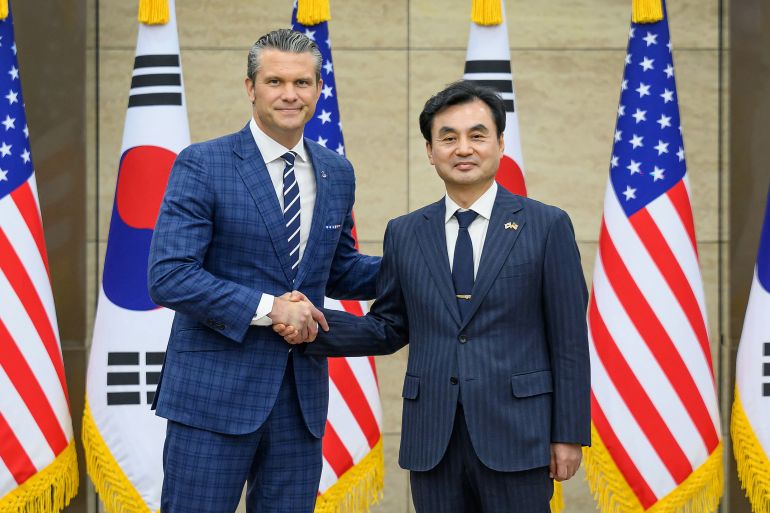US eyes troop ‘flexibility’, increased defence spending in South Korea
Defense Secretary Pete Hegseth says US soldiers may be used in regional conflicts but protecting against North Korea will remain the priority.

By News Agencies
Published On 4 Nov 20254 Nov 2025
Save
The United States defence secretary has visited South Korea to discuss the countries’ military alliance.
On a trip that included a visit to the demilitarised zone with North Korea, Pete Hegseth on Tuesday praised Seoul’s plans to raise defence spending and confirmed that US troops based in South Korea could be used to face regional threats.
Recommended Stories
list of 3 itemsend of list
Hegseth said the 28,500 US soldiers stationed in South Korea might be used in conflicts beyond the peninsula, including with China, but protecting against nuclear-armed North Korea remains the alliance’s primary goal.
“There’s no doubt that flexibility for regional contingency is something we would take a look at,” Hegseth said while standing alongside his South Korean counterpart, Ahn Gyu-back.
US officials have signalled plans to make US forces more flexible in response to a broadening range of issues, such as defending Taiwan or China’s growing military reach.
South Korea, which has 450,000 soldiers, has resisted the idea that the role of US troops could change. But it has also worked to expand its defence capabilities with the goal of being able to take on a wartime command of combined US-South Korean forces.
Boosted budget
Hegseth said the two countries were still working on a joint communique expected to address defence costs, adding that greater military investments by South Korea have been discussed.
In a parliamentary address on Tuesday, South Korean President Lee Jae Myung announced large increases in defence and AI spending.
Lee said next year’s defence budget will grow by 8.2 percent to 66.3 trillion won ($46bn), its biggest increase in six years.
Advertisement
The country will also triple spending on artificial intelligence with an allocation of 10.1 trillion won ($7bn) to facilitate “a major transformation aimed at propelling South Korea into the ranks of the world’s top three AI powers” alongside the US and China.
Overall, the budget plan totals 728 trillion won ($510bn), an 8.1 percent increase from this year.
The pair has also agreed to have South Korea maintain and repair US ships, allowing them to stay in the area and be ready if needed, Hegseth said.
The US official also suggested President Donald Trump will support South Korean plans to build nuclear-powered submarines although he declined to give details.
South Korea has said it could launch a nuclear-powered submarine by the mid-2030s if provided with fuel from the US.
